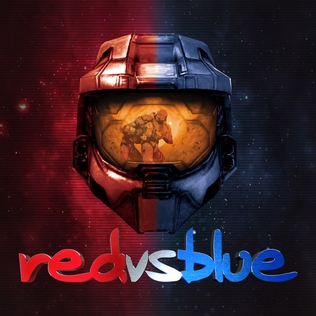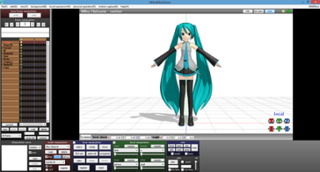
Computer animation is the process used for digitally generating animated images. The more general term computer-generated imagery (CGI) encompasses both static scenes and dynamic images, while computer animation only refers to moving images. Modern computer animation usually uses 3D computer graphics to generate a three-dimensional picture, although 2D computer graphics are still used for stylistic, low bandwidth, and faster real-time renderings. Sometimes, the target of the animation is the computer itself, but sometimes film as well.

Machinima, originally machinema is the use of real-time computer graphics engines to create a cinematic production. Most often, video games are used to generate the computer animation.
Adobe Flash is a multimedia software platform used for production of animations, rich web applications, desktop applications, mobile apps, mobile games, and embedded web browser video players. Flash displays text, vector graphics, and raster graphics to provide animations, video games, and applications. It allowed streaming of audio and video, and can capture mouse, keyboard, microphone, and camera input.

3D Movie Maker is a children's computer program developed by Microsoft Home's Microsoft Kids subsidiary in 1995. Using the program, users can make films by placing 3D characters and props into pre-rendered environments, as well as adding actions, sound effects, music, text, speech and special effects. Movies are then saved in the .3mm file format.

Red vs. Blue, often abbreviated as RvB, is an American comic science fiction web series created by Burnie Burns with his production company Rooster Teeth. The show is based on the setting of the military science fiction first-person shooter series and media franchise Halo. It is distributed through Rooster Teeth's website, as well as on DVD, Blu-ray, and formerly on the El Rey Network and Netflix. The series initially centers on two opposing teams of soldiers fighting an ostensible civil war—shown in increments to actually be a live fire exercise for elite soldiers—in the middle of Blood Gulch, a desolate box canyon, in a parody of first-person shooter video games, military life, and science fiction films. Initially intended to be a short series of six to eight episodes, the project quickly and unexpectedly achieved significant popularity following its premiere on April 1, 2003. The series consists of eighteen seasons and five mini-series. Red vs. Blue is the third longest-running animated webseries of all time, behind Homestar Runner and Neurotically Yours.

Kid Pix is a bitmap drawing program designed for children. Originally created by Craig Hickman, it was first released for the Macintosh in 1989 and subsequently published in 1991 by Broderbund. Hickman was inspired to create Kid Pix after watching his son Ben struggle with MacPaint, and thus the main idea behind its development was to create a drawing program that would be very simple to use.
Previsualization is the visualizing of complex scenes in a movie before filming. It is also a concept in still photography. Previsualization is used to describe techniques such as storyboarding, either in the form of charcoal sketches or in digital technology, in the planning and conceptualization of movie scenes.

Diary of a Camper is a short American film made using id Software's 1996 first-person shooter video game Quake, released in 1996. It was created by United Ranger Films, then a subdivision of a popular group of video game players, or clan, known as the Rangers. The film was first released over the Internet as a non-interactive game demo file. The video is generally considered the first known example of machinima—the art of using real-time, virtual 3D environments, often game engines, to create animated films. The story centers on a lone camper, a player waiting in a strategic location instead of seeking active battle, who faces five members of the Rangers clan in a deathmatch, a type of multiplayer game in which the goal is to kill as many opponents as possible.

Machinima, Inc. was an American multiplatform online entertainment network owned by WarnerMedia. The company was founded in January 2000 by Hugh Hancock and was headquartered in Los Angeles, California.
Open Source Physics, or OSP, is a project sponsored by the National Science Foundation and Davidson College, whose mission is to spread the use of open source code libraries that take care of a lot of the heavy lifting for physics: drawing and plotting, differential equation solvers, exporting to animated GIFs and movies, etc., tools, and compiled simulations for physics and other numerical simulations. The OSP collection provides curriculum resources that engage students in physics, computation, and computer modeling. The code library is in the Java programming language and licensed with GNU General Public License licenses. The site now serves over 10,000 visitors per month. The Open Source Physics Project is an extension of the Physlet Project.

3D computer graphics, sometimes called CGI, 3DCG or three-dimensional computer graphics, are graphics that use a three-dimensional representation of geometric data that is stored in the computer for the purposes of performing calculations and rendering 2D images. The resulting images may be stored for viewing later or displayed in real time. Unlike 3D film and similar techniques, the result is two-dimensional, without the illusion of being solid.

Antics3D was a real-time 3D animation software program published by Antics Technologies. It is used by amateurs and professionals to create 3-dimensional, animated visualisations of events in a variety of industries. Filmmakers form the largest userbase, who use the software for pre-vizualisation, storyboarding and machinima. However, the software is also used in forensic animation, education, training and many other areas which benefit from animated visualisations. The user interface in Antics3D, which is significantly easier than in traditional animation software, has in large part contributed to its uptake in these sectors that lack animation expertise.
iClone is a real-time 3D animation and rendering software program. Real-time playback is enabled by using a 3D videogame engine for instant on-screen rendering.
Jack and Holly is a preschool animated series from the UK that centres on two characters, Jack and Holly. It was launched as a freely available TV series on all IPTV platforms Limited edition DVDs were distributed to children's hospices around the UK on a NFP basis to raise funds for the excellent work and much needed resources these homes need.

MikuMikuDance is a freeware animation program that lets users animate and create 3D animated movies, originally produced for the Vocaloid character Hatsune Miku. The MikuMikuDance program itself was programmed by Yu Higuchi (HiguchiM) and has gone through significant upgrades since its creation. Its production was made as part of the VOCALOID Promotion Video Project (VPVP).
Technologies Nawmal Inc., formerly known as Nawmal Ltd., and simply known as Nawmal, is a Canadian digital entertainment company based in Montreal, Canada, that produces do-it-yourself animation software for the web and desktop and turned words from a script into an animated movie using text-to-speech and animation technologies.
The history of computer animation began as early as the 1940s and 1950s, when people began to experiment with computer graphics – most notably by John Whitney. It was only by the early 1960s when digital computers had become widely established, that new avenues for innovative computer graphics blossomed. Initially, uses were mainly for scientific, engineering and other research purposes, but artistic experimentation began to make its appearance by the mid-1960s- most notably by Dr Thomas Calvert. By the mid-1970s, many such efforts were beginning to enter into public media. Much computer graphics at this time involved 2-dimensional imagery, though increasingly as computer power improved, efforts to achieve 3-dimensional realism became the emphasis. By the late 1980s, photo-realistic 3D was beginning to appear in film movies, and by mid-1990s had developed to the point where 3D animation could be used for entire feature film production.

Disney's Animated Story book is a point-and-click adventure interactive storybook video game series based on Walt Disney Feature Animation and Pixar films that were released throughout the 1990s. They were published by Disney Interactive for personal computers for children of ages 4 to 8 years old. Starting from 1994, most entries in the series were developed by Media Station. They have the same plots as their respective films, albeit abridged due to the limited medium. The games have clickable hotspots that produce animated gags, as well as interactive games.
Based on Id Software's open stance towards game modifications, their Quake series became a popular subject for player mods beginning with Quake in 1996. Spurred by user-created hacked content on their previous games and the company's desire to encourage the hacker ethic, Id included dedicated modification tools into Quake, including the QuakeC programming language and a level editor. As a game that popularized online first-person shooter multiplayer, early games were team- and strategy-based and led to prominent mods like Team Fortress, whose developers were later hired by Valve to create a dedicated version for the company. Id's openness and modding tools led to a "Quake movie" community, which altered gameplay data to add camera angles in post-production, a practice that became known as machinima.

Eddie Duggan is a British photographer, film-maker, screenwriter, author and academic games historian.












